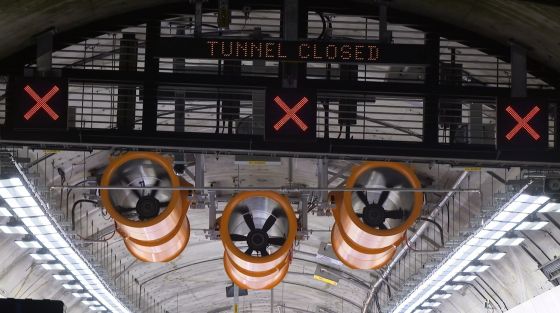Fake fire shows tunnels ready for real emergency
Sunday 9 February 2025

A simulated emergency inside the newly refurbished Heysen Tunnels has shown how effectively the new fire suppression system and traffic management systems operate.
The Australian and South Australian governments committed $150 million (80:20) to deliver the Heysen Tunnels Refit and Safety Upgrade, as part of the broader South Eastern Freeway Upgrade. Major work was completed in late 2024, and saw new systems and equipment installed as part of an extensive refit.
The newly installed fire suppression system - the first of its kind in Australia- was tested last night as emergency crews and tunnel operators responded to a simulated incident where a bus was ‘on-fire’ in the Adelaide bound tunnel.
Staff from the Traffic Management Centre, along with emergency service personnel, used this opportunity to practise responding to an emergency inside the tunnels.
As part of the simulated incident, volunteer participants acted as bus passengers and drivers of cars behind the bus were successfully evacuated, while the misting system and other emergency systems were found to operate effectively.
The fire was simulated using a harmless, non-toxic vapour, giving the illusion of smoke coming from the bus and providing a realistic environment for crews to work with.
Traffic restrictions were in place during the exercise, with both tunnels closed utilising the new traffic management systems installed as part of the upgrade. Vehicles were prevented from entering the tunnels, and traffic was diverted via Mount Barker Road. Heavy vehicles that were Crafers bound were not diverted but were alerted prior to the exercise that they would be briefly held while it was carried out.
The new remotely operated misting-based fire suppression system is the first of its kind in Australia and was installed as part of the upgrade. It works by quickly releasing a heavy mist of water in the tunnels to suppress a fire. Misting systems operate more efficiently than traditional deluge systems, by suppressing any flames and cooling the area. They also use significantly less water while covering a larger area.
Work undertaken as part of the $150 million refit included:
- upgrading the tunnel lighting system to a new LED configuration;
- upgrading the tunnel ventilation system;
- repairing the tunnel lining and installing monitoring equipment;
- upgrading the Intelligent Transport System equipment, including thermal incident detection systems, new and replacement Closed Circuit Television CCTV, Lane Use Management Signs, Variable Message Signage and over height vehicle detection;
- upgrading the traffic management system to restrict access to the tunnels in the event of an emergency incident; and
- upgrading the emergency communication systems, including public address, radio rebroadcast, in-tunnel signage and help phones to improve safety and network reliability.
The project has also seen the installation of:
- over 1,000 LED lights;
- 6 overhead gantries;
- over 140 CCTV and incident detection cameras;
- a pair of 400 kL water tanks; and
- 60 km of cabling.
The Heysen Tunnels first opened in March 2000 and provide a high-speed dual carriageway between Adelaide, the south-east of South Australia and the eastern states. Although constructed to the highest standard at the time, Australian and international standards relating to road tunnel safety have developed significantly since then, so the upgrade has brought this important infrastructure up to current standards.
Simon Brederick, Senior Project Manager for the Department for Infrastructure and Transport says he’s very pleased to see this important test completed successfully.
“Thankfully, there have only been a couple of fires reported in the tunnels’ 25 years history.”
“While we hope we won’t need to use the tunnels’ emergency management systems, in the event of an incident we are confident we have the best available equipment in place and ready.”
“As we approach the tunnels’ quarter century of service, we know they are now well equipped to serve the community for generations to come.”
“A big thank you to drivers for their patience, particularly while required traffic restrictions were in place during the refit works.”